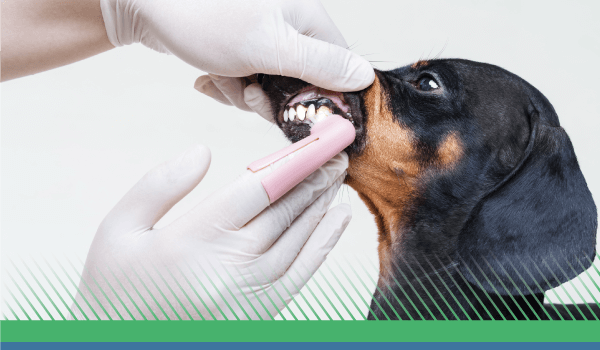February is National Pet Dental Health Month, and Frankfort Animal Clinic likes to mark this important occasion by putting the spotlight on your pet’s teeth.
There’s a reason the veterinary community devotes an entire month to pet dental health. Your pet’s teeth are directly tied to their overall well-being, and even young pets can suffer the beginning stages of dental disease. Did you know that, by age three, 80 percent of dogs and 70 percent of cats show some evidence of tooth decay?
At advanced stages, dental disease can significantly impact a pet’s quality of life, making eating difficult due to mouth pain. Plus, bacteria from the mouth can enter the bloodstream and cause heart, liver, and kidney complications. Keeping up with the cleanliness of your pet’s mouth and their overall dental health can prevent years of discomfort, disease, and lost teeth.
Speaking of prevention, one of the best things you as a pet parent can do to ensure your furry friend’s good dental health is brush their teeth on a regular basis. If you’re intimidated by the prospect of brushing your pet’s teeth, you’re not alone. Here are a few tips to make the process go more smoothly:
· Get comfortable. Instead of standing over your dog, try kneeling or sitting in front of him or her. Practice lifting your pet’s lip to see the teeth and reward with praise.
· Use a toothbrush and toothpaste made for pets. Human toothpaste contains ingredients that may hurt your pet’s stomach. Finger brushes work well for smaller dogs and cats; you’ll need a larger brush with a handle for big dogs.
· Go slow at first. Start with rubbing your pet’s gums and teeth with your finger to see how well they tolerate it. Before using the brush, let them lick some of the toothpaste off your finger or the brush.
· Be gentle. Finish with the bottom front teeth. Focus on the outside of the teeth—the surface facing the cheek is the most prone to plaque and tartar buildup.
· Be patient. Getting used to brushing might take several sessions. Your pet’s gums may bleed a little at first, but it’s only an emergency if bleeding doesn’t stop.
Even with regular brushing, your pet’s teeth will eventually need a professional cleaning. Our
cleanings include a full mouth evaluation, anesthesia and monitoring, cleaning and scaling with an ultrasonic scaler, digital dental radiographs, and polishing. If your pet is over 7, an IV catheter for fluid support might be required.
If it’s been a while since your pet’s smile was seen to, give us a call at 502-227-9611 or schedule an appointment online. Your Franklin Animal Clinic veterinarian will conduct an evaluation of your pet’s dental needs and recommend any procedures and products that might be necessary.

